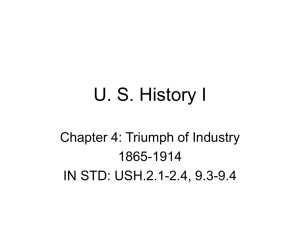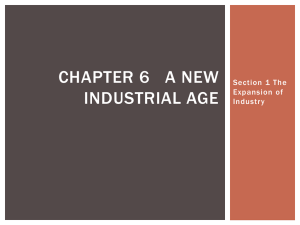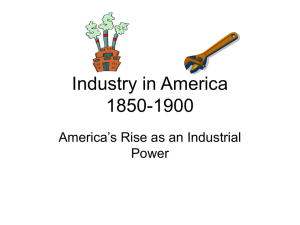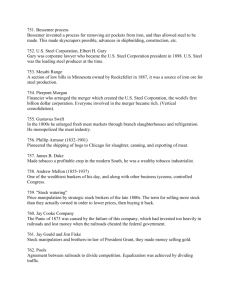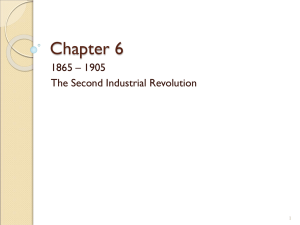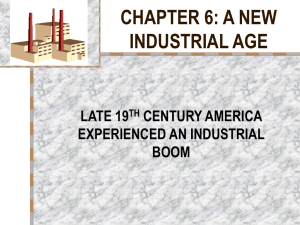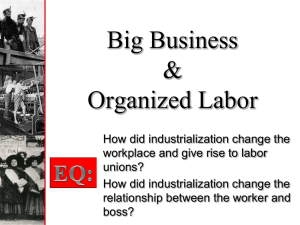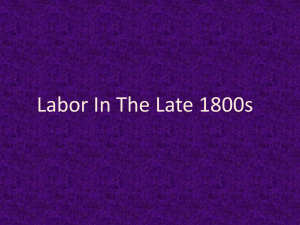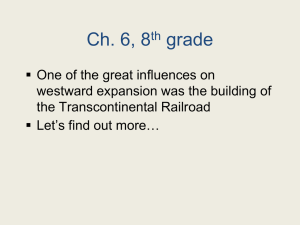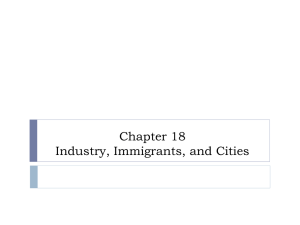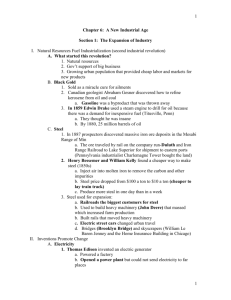Chapter 4 Powerpoint
advertisement
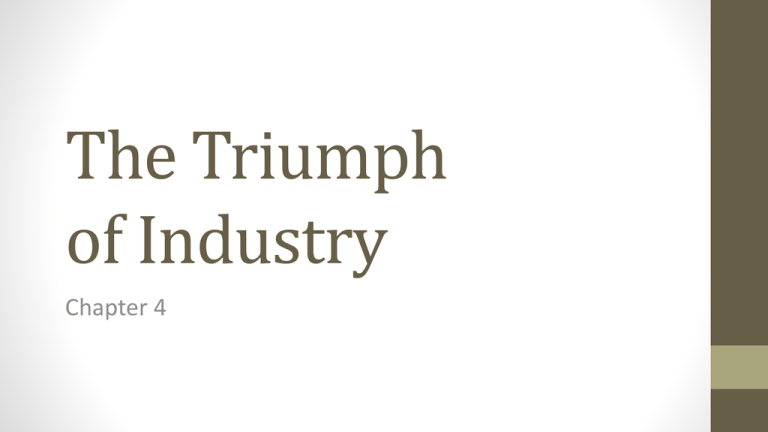
The Triumph of Industry Chapter 4 Technology & Industrial Growth Section 1 1 of 10 Thomas Edison’s bright ideas 2 of 10 An important Thursday Thomas Edison was born on Thursday February the 11th, 1847 in the town of Milan, Ohio. When Thomas was seven his teacher finally lost his patience with his constant questions. He noticed that Tom's forehead was unusually wide and his head was bigger than normal. He made no secret of his belief that Tom’s brains were scrambled! 3 of 10 What do you do when you get home from school? 4 of 10 Maybe you turn the lights on and play Eminem! Music Edison’s first important invention was the phonograph. A machine that could record and reproduce sound. But his greatest success was the development of the electric light. 7 of 10 The first movie star While working on the phonograph, Thomas began working on a device that, "does for the eye what the phonograph does for the ear", this was to become motion pictures. Thomas first demonstrated motion pictures in 1891, and began making "movies" two years later. Early Edison Movies • Edison loved Hip Hop STEEL Taking an invention and turning it into an industry · Scottish immigrant Andrew Carnegie became the “King of Steel”, producing the majority of America’s steel. Andrew Carnegie Andrew Carnegie • This is how he did it. The Steel Industry 1850’s – The Bessemer Process allowed steel to be produced cheaply. · Therefore, the steel industry grew rapidly. Examples: railroads, skyscrapers, nails, pins Bessemer converter At Station Square Steel Production Raw Materials Example: Iron Ore 1 4 Melting Casting Hot air is pumped into a furnace, melting iron at The liquid steel is cast into billets and slabs. 1600 degrees Celsius. (2,912 degrees F) 2 Rolling The billets and slabs are heated and rolled into finished products. 3 Refining Impurities are removed and alloys are added from the molten metal Andrew Carnegie in his “Great Double Role” This cartoon originally appeared in the July 9, 1892 edition of The Saturday Globe, a prounion weekly out of Utica, New York. Caption reads: "Forty-Millionaire Carnegie in his Great Double Role. As the tightfisted employer he reduces wages that he may play philanthropist and give away libraries, etc.” Making Steel • Bill Nye the science guy ; ) RAILROADS AND INDUSTRY Railroad growth • Rapid Growth Growth of Railroads - Once the gauge, or width, of tracks was standardized, railroads formed a network, or system of connected lines. Top: Railroads in 1890 Right: Railroads in 1918 Effects on Industry: - The railroad industry created thousands of new jobs. Examples: steelworkers, lumberjacks, miners, railroad workers - The railroads opened up the country to settlement and growth. Anti-railroad propaganda Abuses: - Railroad companies offered rebates, or discounts, in order to keep or win customers. - This forced many small railroad companies out of business. - In order to end competition and keep prices high, railroad companies agreed to divide up business in an area and set high prices. This was known as pooling. - Railroad companies began to consolidate, or combine, in order to compete with large companies, such as Cornelius Vanderbilt’s. - Cornelius Vanderbilt was one of the richest men in America, and the most powerful railroad baron. Cornelius Vanderbilt - Large companies bought smaller ones or forced them out of business. Cornelius Vanderbilt and James Fisk are shown in a race for control of New York's rails. Vanderbilt unsuccessfully tried to take over the Erie R.R. by buying out its stock. The Rise of Big Business Section 2 Corporations- A new business model Old school- Family owned business New school- Corporation •only risk to inventors is what they invested Vertical and Horizontal Integration Vertical-buy every aspect of making a car HorizontalBuy every company that makes cars Mass Production The development of Mass Production allowed business to produce goods quickly and inexpensively. Mass Production often relied on machinery taking the place of hand tools Old School Production • Hand Made New School-Mass Production • Assembly Line Mass Production-Lucy Style • Sweet Labor Unions Workers fight to end exploitation. The Rise of Labor Unions • 1st were called trade unions • Began as a way to provide help in bad times • Goals: • • • • shortened workdays higher wages better working conditions End child labor Tools of the Union: • Collective Bargaining: negotiations between representatives of labor and management to reach agreement on wages, benefits and conditions • Arbitration: allowing outside “referee” to decide issues between sides • Strike: refusal to work until demands are met Labor Unrest: 1870-1900 Labor Unions . . . . Key Organizations: Knights of Labor: • Opened membership to all workers • Advocated 8 hr. day/ equal pay for equal work • Preferred arbitration to strikes • Under Terence Powderly, expanded membership in 1880’s Terence Powderly Workers Organize Knights of Labor – formed in 1869 as the first labor union in the nation. Goal #3: Equal pay for men and women Goal #1: Shorter work day Goal #2: End child labor American Federation of Labor: • A craft union led by Samuel Gompers • Advocated collective bargaining with threat of strikes • Focused on better pay and benefits • More associated with violence Samuel Gompers AF of L Goals o Catered to the skilled worker. o Represented workers in matters of national legislation. o Maintained a national strike fund. o Evangelized the cause of unionism. o Prevented disputes among the many craft unions. o Mediated disputes between management and labor. o Pushed for closed shops. American Railway Union: • Founded by Eugene V. Debs • Included skilled and unskilled workers • Led way to the foundation of the American Socialist Party • Won successful strike in 1894/ then faded Eugene V. Debs Some Strikes Turned Violent: • Haymarket Square: 1886- confrontation between striking workers and police resulted in several deaths • Homestead Strike: 1892- steel workers against Carnegie fought hired “thugs” • Pullman Strike: 1894- Debs’ workers were attacked by “strike breakers” resulting in President Cleveland sending out troops Sketch of tension leading to violence during the Pullman Strike • • Haymarket Riot Demonstration in 1886 for an eight-hour workday—strikes in many cities At Chicago factory, police broke up a fight between strikers and scabs (workers who replace striking workers)—several workers killed • Led to a protest rally in Chicago’s Haymarket Square—bomb thrown at police, several killed • American public begins to associates unions with violence & radical ideas Homestead Strike: 1892 • Andrew Carnegie’s partner Henry Frick attempted to cut workers’ wages at Carnegie Steel: • Union at plant in Homestead, PA called a strike • Frick used the Pinkertons (a private police force known for their ability to break strikes)—led to shootout with strikers • Following a failed assassination attempt of Frick by radical—union called off the strike Homestead Strike • Andrew Carnegie and the Homestead Strike — History.com Video The Corporate “Bully-Boys”: Pinkerton Agents Pullman Strike: 1894 • Railway workers’ strike that spread nation-wide • Eugene V. Debs called for a boycott of Pullman cars after company refused to bargain with workers • Marked a shift in the federal government’s involvement with labor – employer relations: federal troops were sent A “Company Town”: Pullman, IL Pullman Cars A Pullman porter The Pullman Strike of 1894 Management vs. Labor “Tools” of Management “Tools” of Labor “scabs” boycotts P. R. campaign sympathy demonstrations Pinkertons lockout blacklisting yellow-dog contracts informational picketing closed shops court injunctions organized strikes open shop “wildcat” strikes Gains of Unionism: • Limited work hours • Regulated work conditions • Preserved rights to collective bargain • Rise of violence led public to distrust unions and fear threat of communism (Red Scare)

